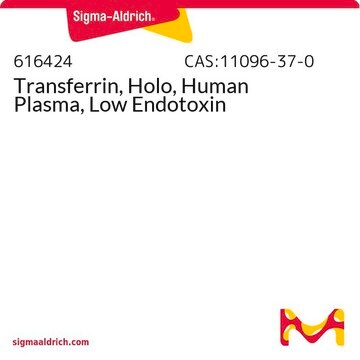T4132
holo-Transferrin human
≥98%
Synonym(s):
Siderophilin, iron-saturated
Sign Into View Organizational & Contract Pricing
All Photos(1)
About This Item
Recommended Products
biological source
human
Quality Level
Assay
≥98%
form
powder
Iron content
1100-1600 μg/g
technique(s)
cell culture | mammalian: suitable
impurities
HIV, hepatitis B and hepatitis C, none detected
UniProt accession no.
storage temp.
2-8°C
Gene Information
human ... TF(7018)
Looking for similar products? Visit Product Comparison Guide
General description
Transferrin (TF) belongs to the family of bilobal glycoproteins, which bind ferric iron. The homologous N- and C-lobes of the protein have a single iron-binding site present in a deep cleft. The gene encoding TF is localized on human chromosome 3q22.1.
Application
Human holo-transferrin has been used:
- in colony-forming assays
- for transferrin uptake and recycling in transfected HEK-293 (human embryonic kidney) cells or bone marrow cells
- for the preparation of luteinizing and non- luteinizing granulose cells
Biochem/physiol Actions
Studies have shown that co-treatment of breast cancer cells with holo-transferrin, which increases iron levels within cells and derivatives of artemisinin results in increased cell death.
Transferrin (TF) is the iron transport protein in the blood. Iron is transported in the serum by binding to circulating transferrin, which in turn binds to receptors on the cell surface. At the alkaline extracellular pH of 7.4, TF binds one or two ferric ions. The iron-bound TF molecules can bind the dimeric transferrin receptor (TfR). At this pH, iron-free transferrin is not recognized by TfR. This is followed by an endocytotic pathway involving the TfR, where the entire complex is internalized by endocytosis. As the pH reduces in the cell, iron is released from TF. The complex then returns to the cell surface and the apo-TF molecules dissociate from the receptor.
Analysis Note
Purity by agarose gel electrophoresis.
Disclaimer
RESEARCH USE ONLY. This product is regulated in France when intended to be used for scientific purposes, including for import and export activities (Article L 1211-1 paragraph 2 of the Public Health Code). The purchaser (i.e. enduser) is required to obtain an import authorization from the France Ministry of Research referred in the Article L1245-5-1 II. of Public Health Code. By ordering this product, you are confirming that you have obtained the proper import authorization.
Storage Class Code
11 - Combustible Solids
WGK
WGK 3
Certificates of Analysis (COA)
Search for Certificates of Analysis (COA) by entering the products Lot/Batch Number. Lot and Batch Numbers can be found on a product’s label following the words ‘Lot’ or ‘Batch’.
Already Own This Product?
Find documentation for the products that you have recently purchased in the Document Library.
Customers Also Viewed
Loss of Dynamin 2 GTP ase function results in microcytic anaemia.
Brown F, et al.
British Journal of Haematology, 178(4), 616-628 (2017)
Hypoxia-inducible factor 1 mediates hypoxia-enhanced synthesis of progesterone during luteinization of granulosa cells.
Yoshioka S, et al.
Journal of Reproduction and Development, 63(1), 75-85 (2017)
EPCR expression marks UM171-expanded CD34+ cord blood stem cells.
Fares I, et al.
Blood, 116(4), blood-b2016 (2017)
Selective toxicity of dihydroartemisinin and holotransferrin toward human breast cancer cells.
Singh NP
Life Sciences, 21, 49-56 (2001)
Atypical serum transferrin isoform distribution in liver cirrhosis studied by HPLC, capillary electrophoresis and transferrin genotyping.
Arndt T, et al.
Clinica Chimica Acta; International Journal of Clinical Chemistry, 394(1-2), 42-46 (2008)
Our team of scientists has experience in all areas of research including Life Science, Material Science, Chemical Synthesis, Chromatography, Analytical and many others.
Contact Technical Service















